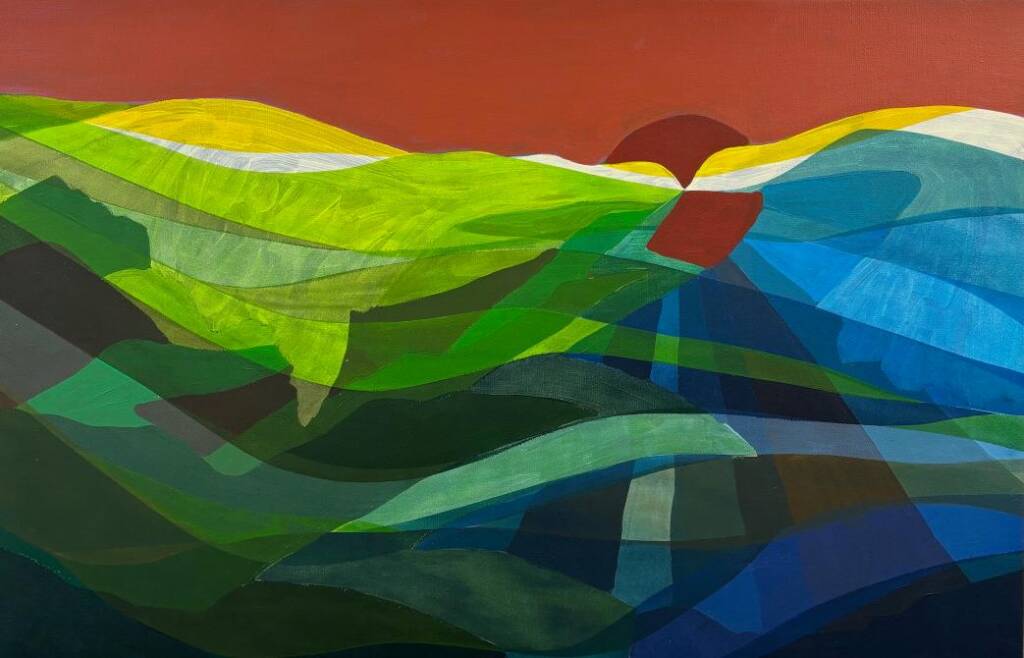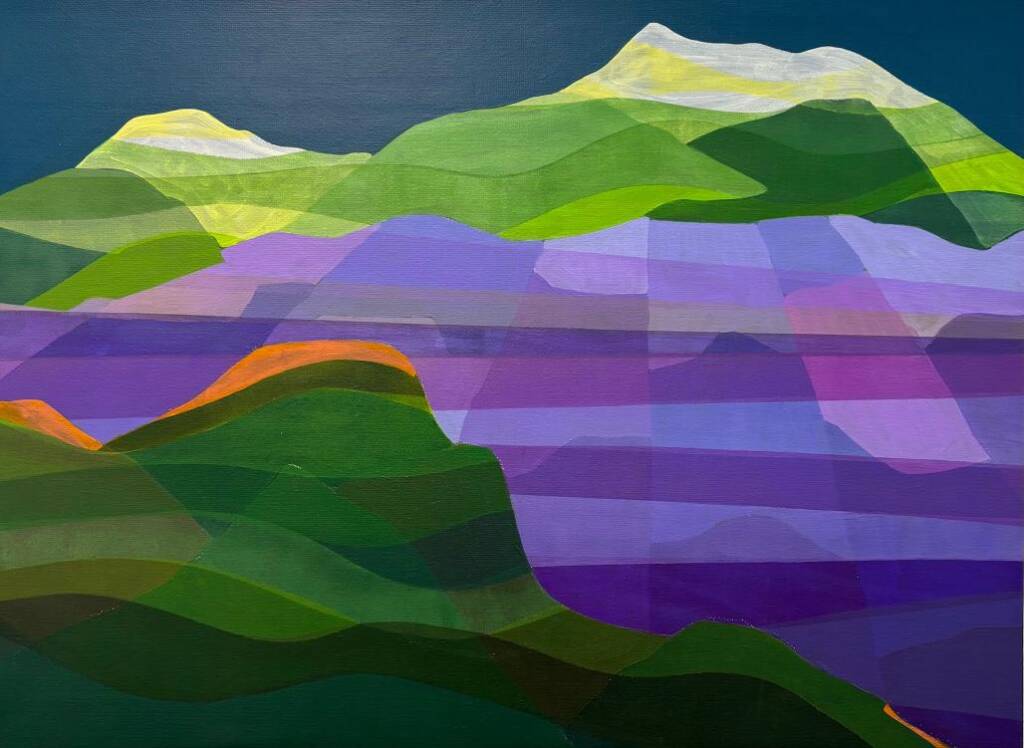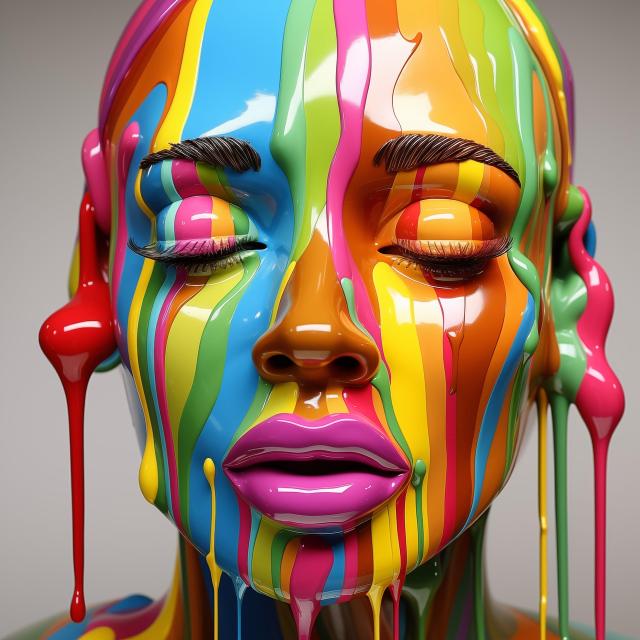An Article by J.A. (834 words, 4 min read)
During February, Mountains of Light, Mazen Khaddaj’s latest solo exhibition, took place at The LT Gallery in Mar Mikhael, Beirut. The exhibition was more than just a showcase of paintings; it was an immersive experience where Khaddaj’s multidisciplinary practice unfolded through layers of color, movement, and emotion.
Returning from Berlin to his hometown of Aley amid wartime, the artist found inspiration in the mountains surrounding him. These landscapes, solid in their presence, became a metaphor for endurance and hope, guiding his latest body of work.
While painting remains a central medium for Khaddaj, Mountains of Light was also a stage for his performative practice. Throughout the exhibition, he engaged in live performances, creating a dynamic interplay between stillness and motion, solitude and connection. His work, both on canvas and in movement, invites viewers to reflect on distance between places, between selves, and between artistic disciplines.
The Performer’s Presence: DISTANCE
One of the most striking moments of the exhibition was DISTANCE, a live performance where Khaddaj went through the complexities of proximity and separation. Having lived between Lebanon and Germany, the artist is no stranger to the feeling of being near yet far. Through deliberate movements and emotional intensity, he translated this experience into a visceral, fleeting moment of expression. His performances in Berlin have long explored the body as a tool for storytelling, and in DISTANCE, that same language of motion resonated within the walls of the Beirut gallery.
Unlike his paintings, which capture a permanent impression of light and form, performance is ephemeral: it exists in a moment, then disappears. Yet, this impermanence is what makes it so powerful. In DISTANCE, Khaddaj’s presence was tangible, yet always shifting, echoing the way he himself has moved through different geographies and identities.


The Painter vs. The Performer: The Performer is Jealous
Beyond the performances, Mountains of Light also featured installations that reflected Khaddaj’s ongoing dialogue between disciplines. The Performer is Jealous was a particularly compelling piece, offering a glimpse into the artist’s internal conflict. As a multidisciplinary creator, Khaddaj has recently devoted more attention to painting, leaving his performer self longing for expression.
This tension was captured through an installation of three boxes, each containing a fisheye lens that allowed viewers to peek inside. What they discovered was an unseen version of Khaddaj the performer, hidden yet present, waiting to emerge. The work plays with visibility and concealment, mirroring the way different aspects of an artist’s practice can compete for attention. Time moves quickly, and while painting currently takes precedence in Khaddaj’s work, the performer remains alive beneath the surface, watching, waiting.
Layering and Transparency: The Emotional Depth of His Paintings
While performance and installation played a vital role in Mountains of Light, the heart of the exhibition remained Khaddaj’s paintings. His layering technique, combined with subtle transparencies, added an emotional depth that resonated with viewers. The mountains in his work are not rigid, static forms; they breathe with light, shifting in tone and intensity, much like the landscapes of Lebanon themselves.
The transparency in his work is particularly significant. It suggests fragility, a softening of reality, allowing different layers to interact rather than stand alone. This technique enhances the emotional impact of the paintings, making them feel alive, as if they are constantly transforming before the viewer’s eyes. The result is an experience that is not just visual but deeply felt – paintings that whisper stories of resilience, belonging, and the search for light in dark times.
Adding another dimension to his work, Khaddaj subtly integrates birds into his compositions, both real and abstract. These birds act as symbols of freedom and transcendence, reinforcing the sense of movement and fluidity in his layered landscapes.

A Soundscape of Stillness and Resilience
The exhibition’s immersive experience was further enriched by a generative ambient sound piece composed by Berlin-based sound artist Milad Samara. His composition blended evolving sequences with field recordings, capturing the stillness, resilience, and quiet force of nature. This sonic layer provided a meditative backdrop, offering a space for reflection, grounding, and light; further amplifying the themes at the heart of Mountains of Light.
A Dialogue Between Art Forms
Mazen Khaddaj’s Mountains of Light was not just an exhibition; it was a conversation between disciplines, between the past and present, between the self and the world. By integrating painting, performance, and installation, the artist created a space where viewers could engage with art on multiple levels.
Whether through the serene yet vibrant landscapes of his paintings, the raw physicality of DISTANCE, or the introspective lens of The Performer is Jealous, Khaddaj challenged the boundaries of artistic expression. He reminded us that art is not confined to a single medium; it is a fluid, ever-evolving force, much like the mountains that inspired him.
Through Mountains of Light, Mazen Khaddaj invites us to stand still, to move, to look closer, and to feel: to reconnect with the resilience within us, just as he has done through his art.


